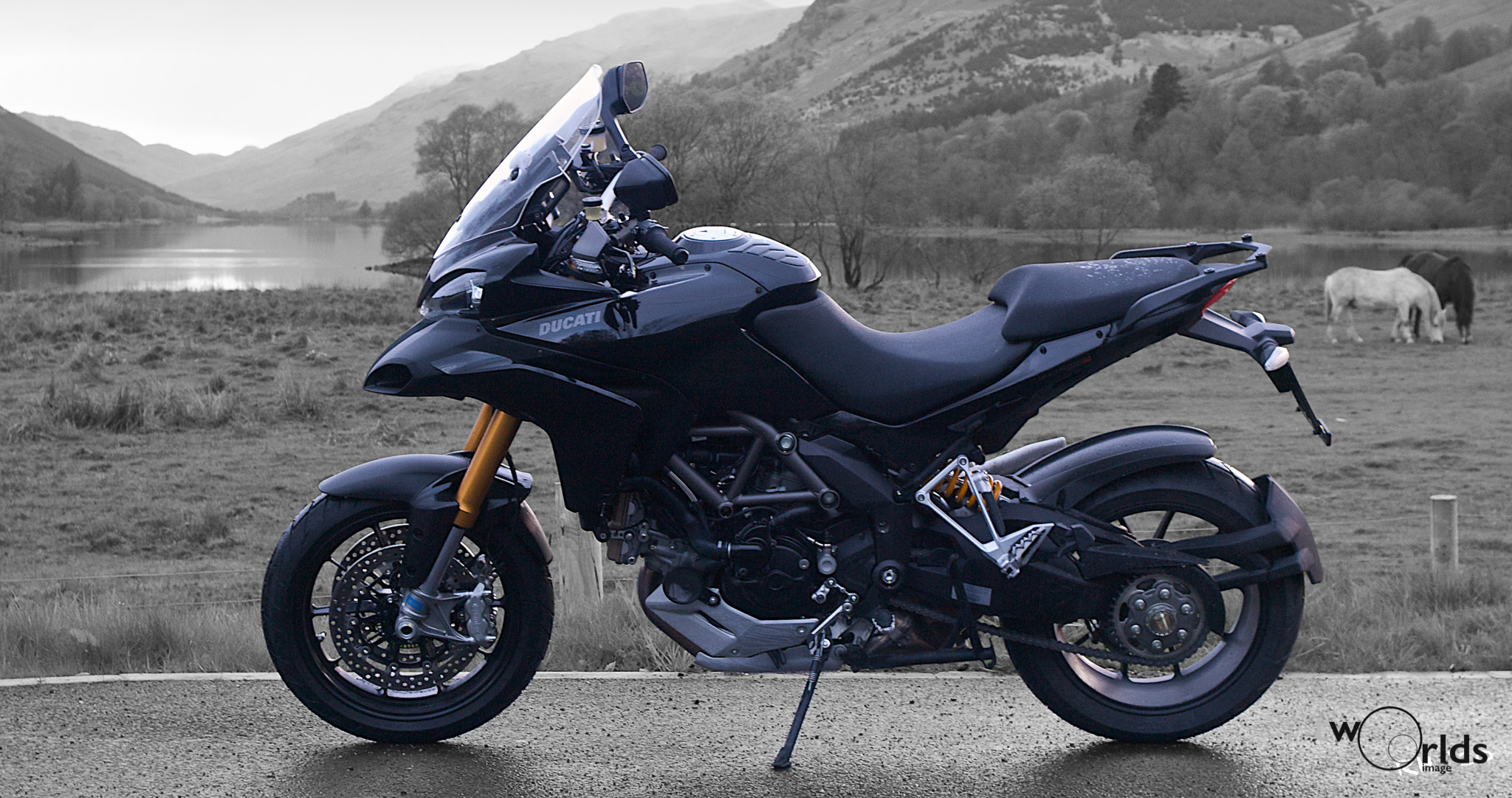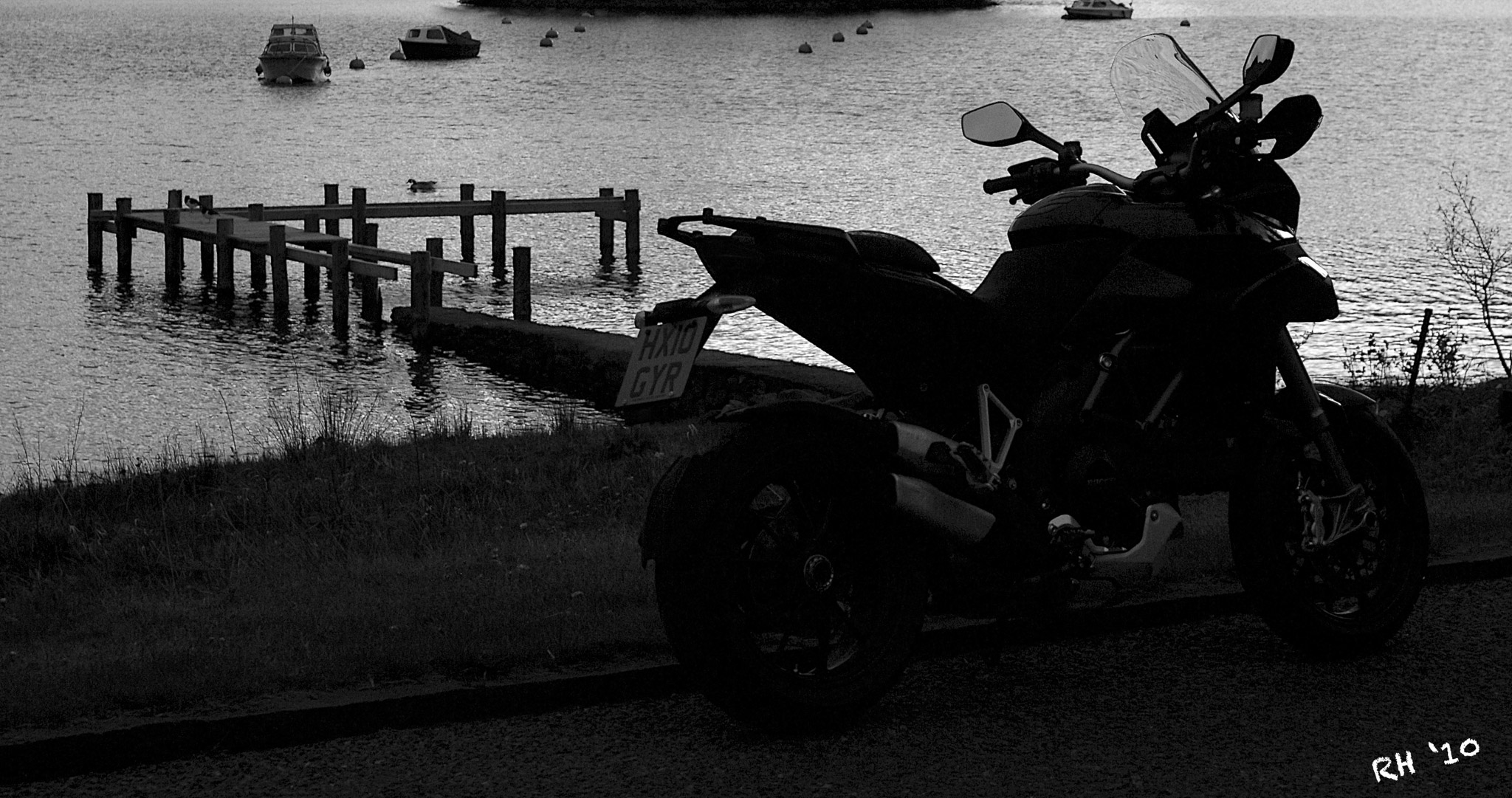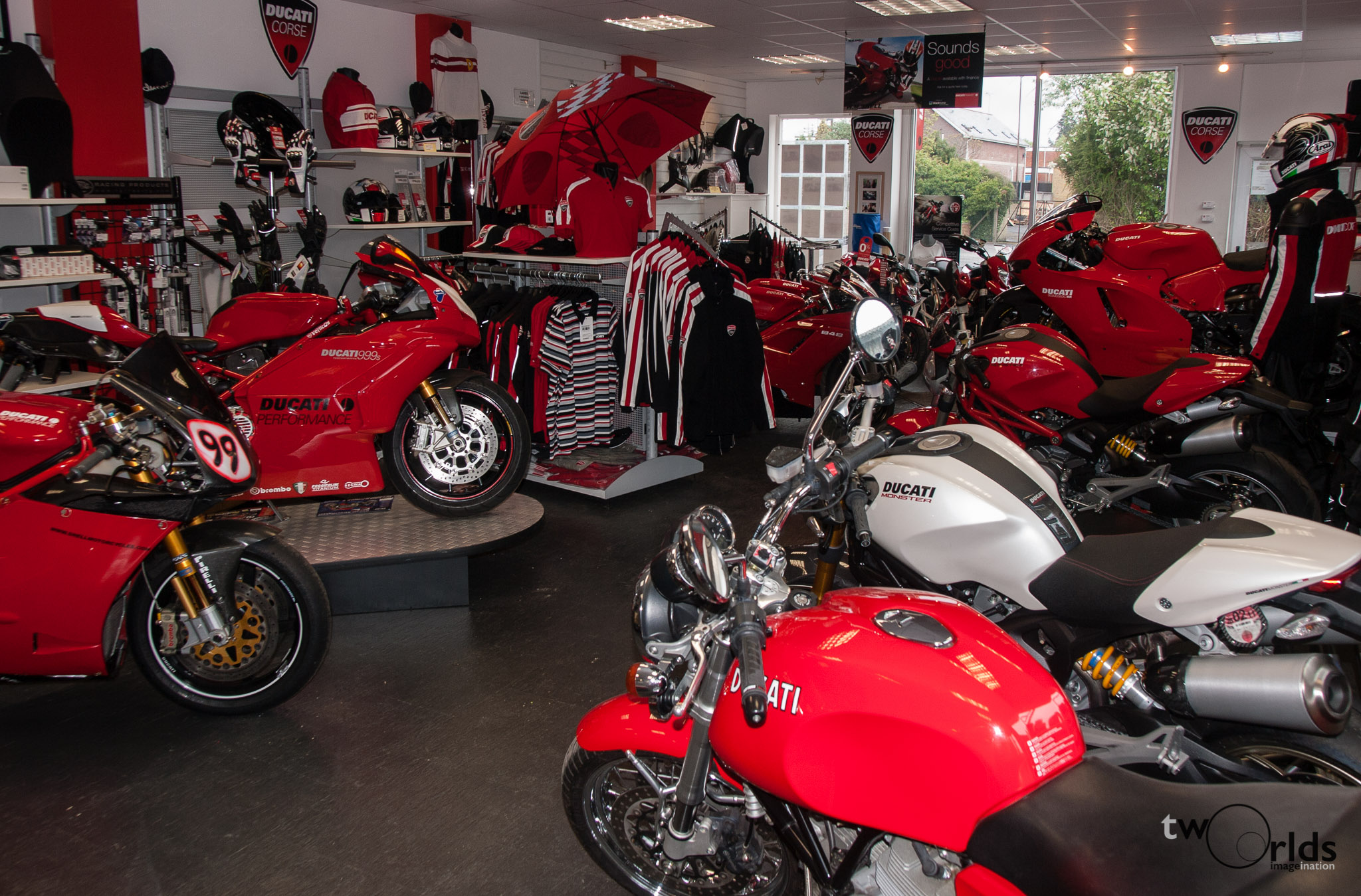Back in the day, a dozen years ago, whenever I ambled into Snell’s of Alton they had a brand new Ducati 749R displayed on a podium. It was a compelling sight, deep red paint glowing radioactively under the shop lights and its carapace of forged alloy, cast magnesium and carbon fibre a blatant display of technoporn. I’ve wanted one ever since. It took a decade, but finances and time finally coincided and, after a two-year search, I came into possession of one of the 400 or so built in 2004 to homologate the machine for World Supersport. Continue reading
Tag: Ducati (Page 1 of 2)
This is turning from an event to a tradition: the day on which Scotland’s Ducatista come out to play at The Green Welly Stop – the highland’s answer to Surrey’s Box Hill. On offer are test rides on the latest and (hopefully) greatest toys from Bologna. This year, they’ve wisely moved from the infeasible optimism of mid-April to early May, thereby much reducing the likelihood of needing snowploughs. And it’s worked: today’s weather was warm, sunny and bike-friendly, especially on the chosen test route: 24 miles of the A85 from Tyndrum to Dalmally, one of the world’s finest motorcycling roads. There is some interesting new stuff this year: as well as the usual and unedifying sight of portly blokes of a certain age contorting creaking joints onto the Panigale, we had the amusement of watching sports and adventure bike riders (self included) wobbling down the road whilst frantically waving their feet in search of the xDiavel’s foot pegs. Yes, Ducati has brought their new ‘Cruiser’ along, which could be considered a brave move on these roads. But you’ll notice the quotes around the C-word there – that just may be a clue that categories may not be a reliable guide to reality. Continue reading
7:30 on a Sunday? Sorry, does not compute. But my phone is binging cheerfully at me, the little sod, a cat is asleep on my head, beloved is a whiffling heap under the duvet and I’m struggling with the concept of needing to be vaguely functional in the next twenty minutes and on the bike in a hour. The intervening time is spent knocking up bacon butties and coffee for self and Fiona, the proprietor of the famed Green Welly Stop, as she drops in en route to Tulliallan for today’s Scottish IAM Motorcycle Forum meeting. I’m worried though: TGW does totally excellent coffee and I need to ensure I’m on decent form to repay the hospitality.
Continue reading
Nothing’s perfect and any new product is going to have its share of things that either need fixing for existing customers or improving for future versions — the test for the manufacturer being how openly and clearly they respond to problems. The Multistrada is no exception here, so herewith my nags and niggles for Ducati:
- The Pannier Lids: While the panniers are well designed for the most part (particularly the handles and locks), it’s mildly annoying that the cutout for the exhaust in the right pannier prevents it from taking a full-face lid (something fixed by the optional wider lids). What’s a lot more annoying is that the lids themselves are, frankly, pants: there’s a 3-4mm gap twixt lid and body at the front, into which the rain does pour. Not good, but Ducati have acknowledged the problem and claim to be working on a fix.
- The Centre Stand. Presumably in an attempt to provide the maximum leverage for getting a fully-laden ‘Strada onto the stand, Ducati have made the stand’s arm far too long: it fouls the rider’s left foot and pushes the stand down, causing it to ground out far too early. And, if you’re like me and ride with the balls of your feet on the pegs, as the pace rises and you put more weight on your feet, the stand gets pushed down further and grounds out more readily the faster you go. Not a good combination. Again, an acknowledged problem and we’re waiting for a fix.
- The Termignoni Carbon Slip-On Exhaust (official Ducati accessory): The heat shield for this bulges out so much that it’s impossible to place your right foot properly on the footrest. It also fouls the centrestand spring, pushing the stand down and causing it to bounce against the bike when riding. Ducati have already issued a redesigned replacement heat shield and I’m just waiting for mine to arrive.
- Low-rpm surging: I’ve mentioned this above and some bikes seem to suffer more than others. I’ve not been particularly plagued by this, but there is a new software map to install, so at least some attempt has been made to address this.
- Pillion Position: this gives me an occasional speed-related pain in the kidneys. Nothing to do with the comfort but with the fact that the step up to the passenger perch means that my beloved can easily see the speedo. Ignorance used to be bliss…
And that’s about it: the encouraging thing being that all real problems have been acknowledged by Ducati, so we’ll wait and see what they actually do about it. There are a couple of other warranty tweaks to be done, but nothing that’s affecting the use or ability of the machine.
Comparisons may well be odious but I’m not about to let that stop me: as I’ve ridden recent examples of some of the bikes with whose market footprints the Multistrada overlaps, here goes with a few highly personal observations, starting with the much-loved R1200GS. And here there’s one thing to get absolutely clear: if you want real off-road ability, buy a GS (1200 or 800) or a KTM with their larger front wheels — the Multistrada with its 17″ front wheel and more road-biased tyres is not a serious off-road machine. That said, it does fine in Enduro mode on forestry tracks, but then most things do, as those of us who followed, sheep-like, a club mate’s GPS down a French mountain bike track a few years ago discovered.
There’s also been a lot of speculation online about the cost of even a trivial off-road drop on the Ducati — whereas a GS will simply land on its cylinder heads (most of the time), the Ducati will go right down on its side unless the panniers are attached. Having previously demonstrated precisely this, I can report at least one off-road tip over without any damage whatsoever.

Multistrada 1200S 2/4: What’s It All About?
Firstly, and for anyone who hasn’t come out of hibernation in the year to date, here’s the what of the new Multistrada, which shares only its name with the previous model. This is a machine with longer wheelbase (in fact about 25mm longer than the R1200GS), long-travel suspension, two comfy seats, an adjustable screen, built-in pannier mounts and dual-purpose tyres. Sounds like a GS then, doesn’t it? But wait, these are Italians we’re talking about: Ducati’s brief to their espresso and adrenaline-crazed design team was very simple: “Build the bike you’d want to ride on the road“. They evidently took that to heart so here we have a machine which in its ‘S’ incarnation has:
- 142 real horsepower delivered at the rear wheel (according to Bike magazine’s dyno — on which the latest GS has just under 100). More to the point, in taking 20bhp off the top-end of the 1198’s engine, they’ve stuck it all back on at the bottom end and mid-range — below 6750rpm, the ‘Strada makes way more power than an 1198, which itself isn’t notably short of low-end grunt. For perspective, a 2010 Honda Fireblade puts out roughly 75bhp at 6000rpm. At the same revs, the Multistrada is punting out about 90bhp. Sure, the ‘Blade has another 20+bhp at the top-end, but the rider has to wind it up first. Meanwhile, the Multistrada is over the hills and far away…
- An all-up weight around 225kg — about 20kg less than a GS, about the same as a VFR800 and just under 20kg more than the current generation of litre-class sports bikes.
- Multiple choices of engine map: full power delivered as fast as you can twist the throttle (wherein it does exactly what it says on the tin), a more relaxed delivery of the same power for touring (especially good for avoiding Nodding Dog syndrome two-up) and a very laid-back 100bhp mode for urban and off-road use.
- Electronically adjustable suspension for everything bar front preload, with four different modes available, each with four sub-modes (labelled solo, solo+luggage, two-up and two-up+luggage), giving a grand total of sixteen suspension modes, all controlled from a handlebar button by an idiot.
- ABS, naturally.
- Traction control, with eight different levels of intervention.
More to the point, all of these bar the ABS are integrated, so that when you switch modes, all adjust at once. And all are completely customisable: you can change settings and assign new settings to any mode or sub-mode. There is also (thankfully) a “Numpty” button to take everything back to stock settings once you’ve terminally confused both yourself and the bike. Oh, and you can switch modes whilst riding — something I was a tad dubious about ahead of time, but it does prove to be a real boon on the road — I can leave Edinburgh, hack across the wet city cobbles in Urban mode (low power, soft suspension and traction control ready to pounce), flip into Touring mode on the motorway (high but relaxed power and firmer but lightly damped suspension to cope with those tedious motorway miles), chop into Sports mode when I peel off onto the glory of my local Highland roads — despatching most visiting sports bikes in the process — and, finally, drop into Enduro mode for the last three miles of broken single track into our village and the near-mile of motocross track that masquerades as our drive. Works for me and the modes really do make a difference to the feel and usability of the bike in each situation.
But how the world does change: it’s 2010 and we’re in a new age of motorcycling (crystals and tepees optional), where bikes compete on techno overkill, on race-derived kudos and in niches within niches (“Sir is looking for a V8 two-stroke motocross scooter, with built-in penguin catcher? In pink? — Step this way…“). So it takes a brave manufacturer to launch a machine that seeks to create a niche for itself by filling many niches — aiming to be, if not all things to all riders, then at least many things to most of us. Which is exactly what Ducati has done with their new Multistrada 1200, the machine with which they’re pitching — in part — for a share of the lucrative adventure tourer or ‘tall-rounder’ market, a market created and dominated by BMW (latterly aided and abetted by a couple of under-employed actors) with their GS series. It’s also a market segment that’s growing rapidly and is, in the process, squeezing the ‘traditional’ sports tourer market where Ducati’s now-defunct ST range sat. Their own previous offering in the adventure bike market was the original Multistrada, the tall-rounder they launched in 2003, using Ducati’s venerable 2v air-cooled DesmoDue engine rather than the superbike-derived Testastretta power plant. Very much a ‘Marmite’ machine, it’s a complete hoot to ride but does lack the ultimate power and space for most peoples’ idea of sporty touring.
I’ve had my Multistrada for just over a month now — time enough to find out the good, the bad and the incomprehensible about it. And yes, it IS as good as the reviews say it is (my own full review has been much-delayed by the simple fact that I’ve been out riding it!) but it ain’t entirely perfect, so here’s my thoughts to date on what can be improved in future and what needs to be fixed by Ducati right now. It’s a very short list, considering that this is a brand new bike designed to appeal to a much wider market than Ducatis of yore — and, by definition, a market less accommodating of Italian, ah, idiosyncrasies. But here they are, in all their ignominy — let’s see what Ducati come back with:
Whilst my natural inclination with a new bike is to start fiddling with its setup pretty much on the way out of the dealers, with The Raven I’ve been giving myself time to slowly get used to it, to play with the various suspension modes and generally suss it out until I understand it enough to start prodding at it. That does however assume that Ducati have pretty much got everything right to the point where, whilst I might want to tweak to taste, there’s nothing I can’t live with. So time to look at the figures.
The graphs below show the electronically adjustable bits of the system and the stock settings for each mode and load (for the Preload settings, the higher the number the greater the preload and, for damping, the higher the number the ‘lower’ the damping effect). Whilst there’s a mostly logical progression – increasing rear preload and commensurate increases, particularly to rebound damping as the load rises, there are a few anomalies in various modes that I’m still trying to work out. Also, rear damping is jumped right up in Two-Up+load in Sport mode – a bigger difference between any other mode and we’re finding that Touring mode is generally a little undersprung and damped and Sport mode slightly overdamped. I’ve a feeling that the rear shock might need respringing – I probably weigh a tad more than the target Italian norm…
In my unending quest to bring enlightenment and knowledge to the world of the Ducatisti, I have taken one more tiny step towards Zen mastery (which must now put me on about the level of the average grasshopper) – this time to answer the speculation on various online fora about the potential cost of an off-road drop of the Multistrada 1200. Here’s the answer: zip. nada. nowt. bugger all. OK, that’s on a sample size of one: your mileage may vary. Turning around on a local forest track, I ran out of steering lock and decided to hop off to back ‘er up, only to discover that the ground was further away than I thought. A lot further away – I’m 6’, with 34″ inside leg, but it still went past its balance point, at which point, whether or not it’s 20kg lighter than a GS became entirely moot – it’s a big, tall bike, and it was gone. Having convinced a couple of passing deer that very bad-tempered bears had been reintroduced to the Highlands, I hauled it back upright. Not a single, solitary scratch, scrape or ding. Relieved, impressed and relieved, in that order. Now off to put an ice pack on my knee…






Recent Comments